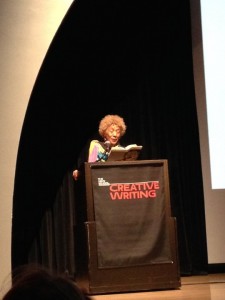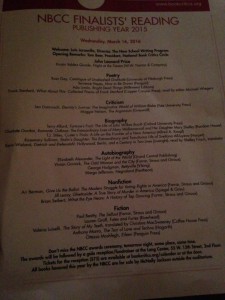Days Getting Longer & Sunsets Lasting Longer
/0 Comments/in Bicycling, Urban Life & New York City /by Philip TurnerFor the first time this year in NYC, the sunset fell after 8pm last night, a kind of celestial milestone on the way to the Summer Solstice June 20th. I pedaled along the Cherry Walk and took a lot of pictures down there along the Hudson River, as the daylight ebbed away, amid a prolonged symphony of color and light. Here’s a thumbnail of those photos just now added to my Flickr album that’s labeled GGB/Sunsets/Hudson. Please visit there for a full sampling of images. 
Exuberant Kids on NY’s Restored High Bridge
/1 Comment/in Bicycling, Urban Life & New York City /by Philip TurnerAs I wrote on this blog in 2013, New York City’s High Bridge is a pedestrian walkway that “connected the Bronx and Manhattan beginning in 1842, an interboro link across the Harlem River that was built to bring fresh water via the Croton Aqueduct in to Gotham. The span connects 170th Street in the Bronx to 173rd Street in Manhattan. In a deliciously arcane example of NYC geography, [a reporter] points out, that’s ‘West 173rd Street and not East,’ though this is the east side of Manhattan, ‘Because it is technically west of 5th Avenue,’ the east-west midpoint of the island for street-naming purposes.”
When I wrote that in 2013 a full renovation of the span was underway, and a few months ago it reopened to the public. Last fall I pedaled up to High Bridge for my first look at the restoration of the span. Here are some pictures I took that day when I was fortunate to come upon some children playing on the new walkway. 



Photos from the Wild, Windy Edge of March
/0 Comments/in Art, Photography, Design, Bicycling, Urban Life & New York City /by Philip Turner Monday dawned gray, rainy, and chilly in New York City. Yet, by around 3pm a new weather front had blown in from the south—in itself unusual—laced with rising barometric pressure, wind gusts that exceeded 40 mph, racing clouds, whitecaps on the Hudson River, higher temperatures, and bright sunshine that lasted until well after 7pm. I was out on my bike as the weather shifted, and despite getting pushed around like a paper sailboat on a lake, I managed to pedal along the river all the way up to what I call Hudson Beach and the Great Gray Bridge. Here are my best pictures from the hours that I enjoyed riding around and reveling in the elements.
Monday dawned gray, rainy, and chilly in New York City. Yet, by around 3pm a new weather front had blown in from the south—in itself unusual—laced with rising barometric pressure, wind gusts that exceeded 40 mph, racing clouds, whitecaps on the Hudson River, higher temperatures, and bright sunshine that lasted until well after 7pm. I was out on my bike as the weather shifted, and despite getting pushed around like a paper sailboat on a lake, I managed to pedal along the river all the way up to what I call Hudson Beach and the Great Gray Bridge. Here are my best pictures from the hours that I enjoyed riding around and reveling in the elements.
National Book Critics Circle Annual Finalist Readings, March 16 2016
/0 Comments/in Book Biz, Books & Writing, Urban Life & New York City /by Philip Turner The National Book Critics Circle’s annual literary extravaganza began last night, a two-night affair I’ve attended every year since the early 2000s (and written about on this blog before). Last night 25 of the authors whose books are finalists for the awards in the six categories which will be given tonight read from their books. No admission charge for the readings or the awards tomorrow, NY’s best free literary program every year. There’s a post-awards benefit tomorrow night, the only part of the wordfest that carries a charge. I’ll be there again tonight. Glad I got good pictures in the darkened auditorium at The New School on West 12th St.
The National Book Critics Circle’s annual literary extravaganza began last night, a two-night affair I’ve attended every year since the early 2000s (and written about on this blog before). Last night 25 of the authors whose books are finalists for the awards in the six categories which will be given tonight read from their books. No admission charge for the readings or the awards tomorrow, NY’s best free literary program every year. There’s a post-awards benefit tomorrow night, the only part of the wordfest that carries a charge. I’ll be there again tonight. Glad I got good pictures in the darkened auditorium at The New School on West 12th St.
Catching a Precious Part of the Day, Pictures March 9 2016
/0 Comments/in Art, Photography, Design, Personal History, Family, Friends, Education, Travels, Urban Life & New York City /by Philip TurnerWith March advancing toward mid-month, I it keeps getting dark later everyday, and on a fine day such as this one was, it was light until past 6:30. I’ve been under the weather, and so not riding my bike this week, but I got down to the Hudson River for the first time in several days late this afternoon, leaving my home office after 5:00. I left work on my desk, lest I lose the chance to see how today’s sunset would turn out, and I wondered if I’d catch much of the light. As many who know me and this blog may attest, I have an appetite for late afternoon light. The amazing thing about living on the west side of Manhattan? We happen to have great sunsets, especially right at the river edge, or standing on the bluff above in Riverside Park, peering across to the river, with New Jersey on the far shore, and the rest of the continent beyond. I live near the park, and appreciate this practically every day. My appreciation of the neighborhood—the enchanted landscape and majestic bridge amid all the urban-ness, with people running, biking, walking dogs, plus the noise, aircraft overhead, traffic rushing by on the West Side Highway, and the light—began in 1990. I moved to the upper west side that year and had a Senior Editor job with Prentice Hall Press, then a division of Simon & Schuster. PHP staff were located—not in Rockefeller Center as S&S was, and is still—but in the office tower just north of Columbus Circle known then as the Gulf & Western Building. I had a small office with a window that invited me to peer westward across the Hudson, out toward America. We were on a pretty high floor, above the thirtieth, and it used to really sway in heavy weather. They do that, one hears, but it felt a bit like being on a ship. The building overlooked Central Park on the side away from my office, a great nabe to work in from July 1990-July 1991.
it keeps getting dark later everyday, and on a fine day such as this one was, it was light until past 6:30. I’ve been under the weather, and so not riding my bike this week, but I got down to the Hudson River for the first time in several days late this afternoon, leaving my home office after 5:00. I left work on my desk, lest I lose the chance to see how today’s sunset would turn out, and I wondered if I’d catch much of the light. As many who know me and this blog may attest, I have an appetite for late afternoon light. The amazing thing about living on the west side of Manhattan? We happen to have great sunsets, especially right at the river edge, or standing on the bluff above in Riverside Park, peering across to the river, with New Jersey on the far shore, and the rest of the continent beyond. I live near the park, and appreciate this practically every day. My appreciation of the neighborhood—the enchanted landscape and majestic bridge amid all the urban-ness, with people running, biking, walking dogs, plus the noise, aircraft overhead, traffic rushing by on the West Side Highway, and the light—began in 1990. I moved to the upper west side that year and had a Senior Editor job with Prentice Hall Press, then a division of Simon & Schuster. PHP staff were located—not in Rockefeller Center as S&S was, and is still—but in the office tower just north of Columbus Circle known then as the Gulf & Western Building. I had a small office with a window that invited me to peer westward across the Hudson, out toward America. We were on a pretty high floor, above the thirtieth, and it used to really sway in heavy weather. They do that, one hears, but it felt a bit like being on a ship. The building overlooked Central Park on the side away from my office, a great nabe to work in from July 1990-July 1991.
Quick as I could, I scrambled down there on foot and found the light this evening was extraordinary, and still evolving as a long drawn out event. These picture were taken near the Oscar Hijuelos Tennis Courts, the handsome clay ones, located along Manhattan’s west side river at around 96th St. It was one of the finest sunsets in all the years I’ve been photographing the Great Gray Bridge, the shore, upper Manhattan, the New Jersey side, always reveling in the light and atmosphere, and it lasted longer than most. You may click here to see more from tonight. And, if you want to see more photos like these, you can visit my flickr album labeled “GGB/sunsets/Hudson.”
Pictures of the Week along the Hudson River—Sunsets, Clouds, and the Great Gray Bridge
/3 Comments/in Bicycling, Urban Life & New York City /by Philip TurnerA New Flickr Album Chock-full of Hudson River and Great Gray Bridge Photos
/0 Comments/in Art, Photography, Design, Bicycling, Urban Life & New York City /by Philip TurnerAs readers of this blog may’ve noticed, I am fond of photographing the George Washington Bridge, the Hudson River, and sunsets along the shoreline on my regular bike rides in upper Manhattan. While I post many of those photographs in my social media accounts (on my Instagram; Facebook; and Twitter accounts), in truth I take more pictures than I can reasonably share on those platforms. Not all are good, but enough are that the circumstance motivated me to start a Flickr album I’ve labeled GGB/sunsets/Hudson as a repository for the greater bulk of those photos. If you enjoy those pictures, as many friends tell me they do, I invite you to visit the Flickr album for many more views of the sort like the ones shown here..
https://www.flickr.com/photos/127162161@N07/sets/72157663551324326

